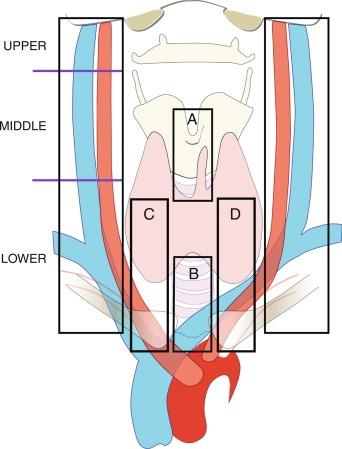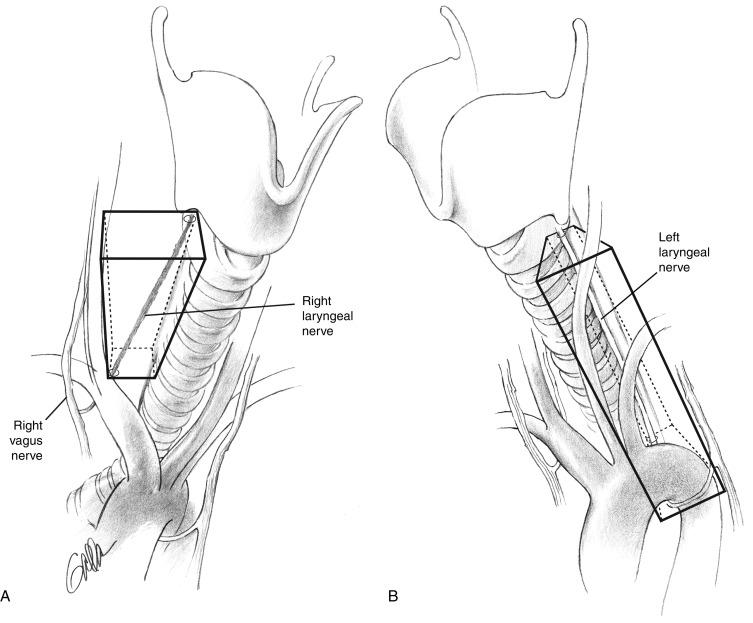Physical Address
304 North Cardinal St.
Dorchester Center, MA 02124
Introduction to Chapter 38, Central Neck Dissection: Indications and Technique.
Central Compartment Dissection.
Central lymph node metastasis is very common in differentiated thyroid cancers, especially in papillary thyroid carcinomas (PTCs). Although therapeutic central neck dissection for cN1a is widely accepted, there continues to be ongoing debate regarding the role of elective/prophylactic central compartment dissection for cN0 necks. In a 2016 meta-analysis that reviewed 37,655 patients with PTC, the incidence of occult metastasis in the central neck (pN1a) in cN0 necks was reported to be 26.4%. Others have reported that occult or micrometastases may be present in up to 90% of well-differentiated thyroid cancer (WDTC). This chapter outlines the pertinent surgical anatomy of the central compartment, the indications and ongoing debate for central neck dissection in differentiated thyroid cancer, and detailed surgical technique in performing a safe and comprehensive central neck dissection.
The first echelon of lymph nodes in metastatic thyroid carcinoma are located in the central compartment of the neck and consists of four major nodal basins: prelaryngeal (Delphian), left paratracheal, right paratracheal, and pretracheal. Beyond these areas, parapharyngeal, retropharyngeal, retroesophageal, and superior mediastinal regions may also rarely be involved. The central neck lymph nodes include level VI and VII, which are based on the seven-compartment neck nomenclature; the lateral neck includes levels I to V. In level VI, the anatomic boundaries are the hyoid bone (superior), sternal notch (inferior), carotid sheath (laterally on each side), prevertebral fascia (posterior), and the undersurface of the sternothyroid muscle (anterior). Level VII lymph nodes are in the compartment inferior to level VI and are bordered by the innominate (brachiocephalic) artery ( Figure 38.1 ). Inferiorly on the left side, the innominate artery does not extend into the paratracheal region; therefore the corresponding plane of the innominate crossing the trachea on the right defines the inferior border for the left side. Keep in mind that the sternal notch and the innominate artery have a variable relationship with the artery rising above the notch in 25% of cadaveric dissections; thus vigilance for high-riding innominate artery is needed, and variability in the definition and exact extent of the surgically approachable caudal central neck exists. Mediastinal lymphadenopathy that is located caudal to the innominate vein adjacent to the tracheal bifurcation is rare and is significantly associated with poorly differentiated tumors. The central neck and its major compartments are all readily available at primary thyroidectomy surgery.

The recurrent laryngeal nerves (RLNs) ascend the paratracheal spaces in different positions depending on the side of the neck and understanding this anatomy is vital when performing central neck dissections. Because of the different positions of the right subclavian artery and aortic arch relative to the midline trachea, the right RLN ascends the right paratracheal region obliquely extending from inferolateral to superomedial. The left RLN, however, ascends the neck in a more caudal-to-cranial direction in the tracheoesophageal groove. Furthermore, the right RLN is more ventral at the base of the paratracheal region than the left because of the relative ventral position of the subclavian artery compared with the aortic arch. Because of this ventral placement of the right RLN, nodes can be hidden deep to the nerve; therefore special attention should be paid in this region to ensure a thorough right paratracheal dissection. The number of nodes in the paratracheal nodal basins range widely from 3 to 30 in number depending on a number of factors, but a central neck dissection specimen is typically associated with an average of eight nodes on pathologic examination ( Figure 38.2 ).

A multidisciplinary collaborative working group from the American Thyroid Association (ATA) published a consensus statement on central neck dissection terminology and classification for thyroid cancer in 2009. In this statement, emphasis was placed on the importance of using consistent terminology for indications of central neck dissection (i.e., therapeutic versus elective/prophylactic), as well as for use in operative notes and publications. Therapeutic dissection involves removal of nodal metastases identified preoperatively or intraoperatively as containing metastases termed “clinically apparent” (clinically N1). Elective or prophylactic dissection involves removal of lymph nodes that do not appear to contain metastases (clinically N0).
Defining the extent of central neck dissection (i.e., unilateral or bilateral) was also clarified by anatomic terms in the consensus statement. Unilateral central neck dissection involves comprehensive removal of pretracheal and prelaryngeal node-bearing tissue along with unilateral paratracheal node removal. Bilateral dissection includes removal of pretracheal, prelaryngeal, and bilateral paratracheal nodal basins (see Figure 38.1 ). Importantly, comprehensive central neck dissection, either unilateral or bilateral, is a compartmental dissection and is distinguished from node plucking (i.e., berry picking ) of only the macroscopically involved nodes. This practice is associated with higher rates of recurrence, which brings increased risk of morbidity given the need for reoperative surgery. Thus, when clinically apparent nodes are detected during surgery, a comprehensive central compartment dissection is warranted.
The risk of regional recurrence is higher in patients with palpable lymph node metastasis (cN1). In patients with clinically apparent nodal disease, as evident on clinical examination, preoperative imaging or intraoperative findings, therapeutic central neck dissection (level VI and VII) is well accepted and indicated at the time of thyroidectomy. This comes as a strong recommendation by the 2015 ATA guidelines for management of differentiated thyroid cancer. Therefore vigilance is required pre- and intraoperatively to accurately detect clinically evident nodal metastasis requiring central neck lymphadenectomy. The rationale for therapeutic central neck dissection at the time of thyroidectomy is relatively straightforward—namely to comprehensively remove all grossly evident nodal disease, along with any adjacent subclinical disease; this is done to minimize risk of recurrent/persistent disease and potential morbidity from reoperation for clinically evident disease initially undertreated. Detecting macroscopic disease and operative planning can be achieved by preoperative imaging using high resolution ultrasound (US) or computed tomography (CT) with contrast.
The extent of therapeutic central neck dissection can be either unilateral or bilateral. Bilateral dissection is clearly required and indicated at the time of initial surgery when clinically apparent disease is present in both paratracheal regions. Bilateral central neck dissection definitely increases the risk of hypoparathyroidism and theoretically bilateral recurrent nerve injury resulting in potential airway complications. However, this surgery results in a high clearance rate of structural disease and should be performed when the benefits are clear. At the time of thyroid surgery for PTC, metastatic lymph nodes often appear to have a dark blue or black appearance. This occasionally can be confused with anthracotic lymph nodes, which may have a similar look, but (upon close inspection) appear to have a powderily, specked, black, particulate, and charcoal-like material within. Frozen pathology at times of uncertainty may be helpful in these instances for surgical decision-making. Further clues to the presence of metastatic disease at the time of surgery include central lymph nodes that are larger than 1 cm; however, size can be considered less reliable in the setting of coexisting thyroiditis, for which frozen section can be helpful.
Become a Clinical Tree membership for Full access and enjoy Unlimited articles
If you are a member. Log in here